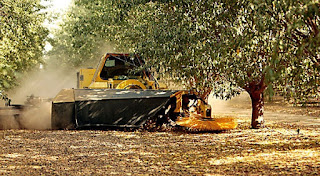We’re all familiar with the shell game.
You shuffle the shells and guess where the hidden pea
is.
Well, field scout Jenna Mayfield offers her own
version of the shell game. Call it the almond shelling game – an annual event
that takes place every fall after the almond harvest.
 |
| Harvest samples are taken after nuts are shaken to the ground. |
Among industry and academic research circles, Jenna’s
version is better known as crackout. The University of California Integrated
Pest Management program calls the practice a cost-effective way to manage pests
for the coming season.
Before
we get into more detail about pest management, let’s start at the beginning in
which growerscollect samples from various locations in the orchard during the
harvest.
Jenna picks up samples for about two dozen growers.
She collects nuts shaken from trees in three separate areas in an orchard where
pest traps were placed. Jenna gathers about 200 nuts from each variety planted
in the orchard. Growers will plant different almond varieties in every orchard.
If there are three varieties in the orchard, then Jenna will pick up a total of
600 nuts in all.
Cracking the nuts and inspecting each one helps
confirm what she discovered in the orchards during scouting this season, Jenna
says.
Jenna inspects each kernel, writes down her findings
from every orchard and provides a report to every grower. The findings indicate
how well the grower’s pest management practices fared during the season. Growers
also can compare the results to a grade sheet received from the huller.
The practice gets positive reviews from UC extension advisors. |
| Almond pest damage could be hidden by sweeping. |
damage in harvest samples than what was indicated in the grower’s processor report. In other words, when we found an estimated 5 percent damage/reject level in the harvest sample, the processor indicated a 1 percent rejection level. The 4 percent discrepency is most likely due to damaged nuts lost during the steps of harvest.”
He goes on to say that a harvest sample accounts for damage that does occur in the field. “Often times processors lump all worm damage together, not separating out NOW (navel orangeworm), PTB (peach twig borers) or other worms. Ant damage often does not show up because the chewed out pellicles are blown out the back of the pick-up machine. Gummy nuts due to deficiencies, feeding, or other conditions are all lumped together.”
Jenna adds that nut sampling is a good way to
identity past pest damage and predict potential future damage. Moreover,
experts say crackout prevents growers from making the wrong assumptions about
pests.
No comments:
Post a Comment